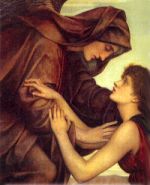Catholic Activity: October 31 — Halloween
Katherine Burton traces the origins of many traditional customs on Halloween.
DIRECTIONS
A very ancient celebration is this the Eve of All Saints. In pre-Christian eras it was a day when the Druids gathered within a ring of stone and chanted runes. The Romans celebrated it with an autumn feast to Pomona, goddess of orchards.
In the calendar of the Church this is a fast day, but, especially in Ireland, many interesting dishes have been evolved to tide one over to the next day's feast of All Saints. Fast days often seem to inspire cooks to concoct palatable foods of a vegetarian nature. Of these the counties all have their favorites, most of them based on the potato, that basic commodity from the Irish fields. But no matter what the food, there is always placed in the dish a wedding ring wrapped in grease-proof paper, and this is said to decide the future of the person finding it.
Tyrone, Cavan, and other counties indulge in boxty dishes and also in many verses about them. One runs:
Boxty on the griddle,
Boxty on the pan,
The wee one in the middle
It is for Mary Anne.Boxty on the griddle,
Boxty on the pan —
If you don't eat boxty,
You'll never get your man.
And another:
Two rounds of boxty baked on the pan,
Each one came in got a cake in her han';
Butter on the one side,
Gravy on t'other
Sure them that gave me boxty
Were better than my mother.
These boxty dishes include boxty dumplings and boxty bread and boxty pancakes (see recipes, some for Shrove Tuesday).
The same countries feature on Halloween Potato Pudding and Colcannon (see Saint Patrick's Day).
In Scotland a special cake is made, and charms wrapped in paper are stirred in before it is baked. These are the usual ring, button, thimble, and coin, with the addition of a horseshoe for good luck, a swastika for happiness, and a wishbone for the heart's desire.
In England, as also in the United States, it is a night for feasting before an open fire, on cider and nuts and apples, and was formerly known as Nut Crack Night.
Far back in history runs the list of games played on that night, many of them still popular, such as bobbing for apples in a tub of water, or trying to take a bite from one swinging on a cord, or that slightly more dangerous but fascinating sport of snapdragon, in which raisins were placed in a bowl of brandy and the liquid set on fire, the point of the game being to extract the raisins without burning oneself — surely a better game to win than to lose.
Although Halloween is the eve of a solemn church festival, its celebration has always been associated with witches and hobgoblins and ghosts; in the past it was at times an occasion for the practice of sorcery and incantations, and even of cruelty. Today it is a night of fun, which even at its worst seems to consist in the carrying away of gates or porch furniture. We have all seen the children, dressed in grotesque ways, who go about asking for candy and pennies. Familiar is the sight of the small boy coming home with a bag full of edibles — candies, cakes, nuts, gum, enough for several meals — and a good stack of pennies.
Grown-ups, whose duty for the evening seems to be to provide the handout, might spend their own evening by making it a Nut Crack Night. Sitting before a bright hearth fire, they can feast on the appropriate foods of the night and of the season — cider and apples and nuts.
Activity Source: Feast Day Cookbook by Katherine Burton and Helmut Ripperger, David McKay Company, Inc., New York, 1951






